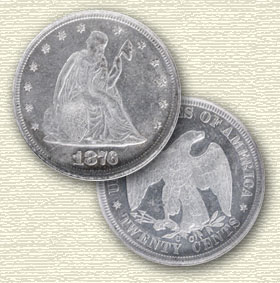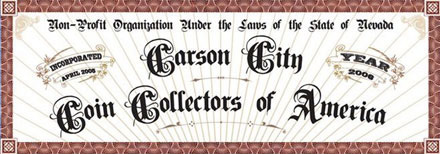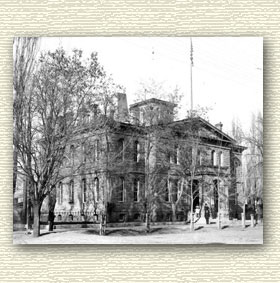- Posts: 176
- Thank you received: 0
1876-CC Gold Double Eagle Coin of the Week Nov.14, 2010
15 years 1 month ago #1635
by randysc
1876-CC Gold Double Eagle Coin of the Week Nov.14, 2010 was created by randysc
With the year 1876, we saw the nation turn one hundred years. To mark it with celebration was the Centennial Exposition, which started in May of that year and lasted to November, held in Philadelphia. It was the first "World's Fair" that was held in the United States. All states and territories and forty nine foreign countries were represented. Approximately ten million people came to the exposition to see the United State's first "international exhibits of the arts, manufactures and products of the earth" with the feeling that the U.S. had grown up and taken its place among the nations of the world in commerce and industry. We were no longer a "new" nation. We were established with states on both coasts, gone through growing pains that almost tore us apart in a war that pitted brother against brother just eleven years previous. This exposition would allow us to look forward to an optimistic future.
As stated, all states were represented and of course, so was Nevada. Its exhibit building had displays featuring items associated with the Comstock Lode, such as pictures of mines, authentic mining gear, silver and gold ingots. The Carson City Mint was also represented with coins bearing the renowned "CC" mintmark in display. One unique item that was made available at the exposition from the state of Nevada, was the Nevada-1876 U.S. Centennial Exposition so-called dollar. Created by U.S. Mint engraver William Barber (Charles' father). A rather attractive medal which had on its obverse, the Liberty Bell between a Minute Man on the left side and the year 1776 and on the right side a soldier with the year 1876 with clouds below. Above has a ribbon with the word "Centennial". The reverse side has what looks to be the Seal of the State of Nevada. Two thousand five hundred twenty six of these medals were struck from Nevada silver ore, most likely from the Comstock Lode, and sold for $1.25 during the Exposition. These medals are available today however they cost a bit. As I write this piece, one is on Ebay, certified by NGC VF-20 with a "Buy it Now" price of $650 or best offer.
Nevada was one of the nation's younger states, having coming into the union only a dozen years previous and in its capital, Carson City, the federal mint there had been in operation only a half dozen years, but 1876 would prove to be the most productive for the young mint. A total of 15,839,024 coins were minted for a face value of $6,402,215. Half of the C.C. coins denominations minted in 1976, saw an increase in mintage numbers from the previous year and the double eagle was one of them. A total mintage of 1876 C.C. double eagles came to be 138,441, an increase of 27,290 from 1875. It still was third of all mints producing double eagles that year with San Francisco totaling 1,597,000 and Philadelphia with 583,860.
1876 was a transition year for the double eagle. It would be the last year for the Type II reverse, where the denomination was written as "TWENTY D.". Next year would be the start of the Type III reverse, where the denomination is fully written as "TWENTY DOLLARS".
With the 138,441 mintage totals for the 1876-CC double eagle, it is the highest mintage figure out of all Carson City double eagles, but at one time it was one of the more difficult one to obtain in uncirculated condition. In 1993-94 a hoard of three to four dozen uncirculated examples were released to the market. After that, more have since surfaced giving the total survival numbers in mint state condition to be around 375. About 4,500 are estimated to be the survival number in all grades. That still seems to be a low number for being the most available Carson City double eagle.
Strikes are pretty good, sometimes a little weak in the hair definition of the curls and the radial lines in the stars of the obverse, but the reverse has close to full detail on the eagle's feathers and in the shield. The surface is another matter however. The 1876-C.C. double eagle is nortorious for surface abrasions due to heavyhandling during shipping, the coins rubbing against each other as the coin bags are tossed around in route to financial institutions. Also copper spots can be found on a number of pieces. Because of its heavily abraded surfaces, the eye appeal for this date is usually considered below average. Though "baggy" it is possible to find some that have good detail, coloration and excellent luster.
Luster is generally good ranging to frosty to simi-prooflike. there are some 1876-C.C. double eagles known to be fully prooflike and, if not to abraded, can be very visually appealing.
As far as varieties, there are a couble mint mark variations, but nothing so extreme as to command any additional premium.
Prices, as according to Numismedia Fair market Value price guide (and it is just a guide) are as follows for each grade:
G- $1710 / VG- $1740 / F- $1840 / VF- $1880 / EF- $2190
AU50- $2470 / AU55- $3450 / MS60- $10,530
To assemble a complete set of Carson City double eagles can be done, but it would require somewhat of a sizable bank account, not something that can be done by the average Joe. But if one desires to put together a Carson City Gold type set, or a complete Carson City coinage type set, then the 1876 C.C. double eagle, because of its readily availability and modest pricing, would indeed be the coin to seek. Enjoy.
As stated, all states were represented and of course, so was Nevada. Its exhibit building had displays featuring items associated with the Comstock Lode, such as pictures of mines, authentic mining gear, silver and gold ingots. The Carson City Mint was also represented with coins bearing the renowned "CC" mintmark in display. One unique item that was made available at the exposition from the state of Nevada, was the Nevada-1876 U.S. Centennial Exposition so-called dollar. Created by U.S. Mint engraver William Barber (Charles' father). A rather attractive medal which had on its obverse, the Liberty Bell between a Minute Man on the left side and the year 1776 and on the right side a soldier with the year 1876 with clouds below. Above has a ribbon with the word "Centennial". The reverse side has what looks to be the Seal of the State of Nevada. Two thousand five hundred twenty six of these medals were struck from Nevada silver ore, most likely from the Comstock Lode, and sold for $1.25 during the Exposition. These medals are available today however they cost a bit. As I write this piece, one is on Ebay, certified by NGC VF-20 with a "Buy it Now" price of $650 or best offer.
Nevada was one of the nation's younger states, having coming into the union only a dozen years previous and in its capital, Carson City, the federal mint there had been in operation only a half dozen years, but 1876 would prove to be the most productive for the young mint. A total of 15,839,024 coins were minted for a face value of $6,402,215. Half of the C.C. coins denominations minted in 1976, saw an increase in mintage numbers from the previous year and the double eagle was one of them. A total mintage of 1876 C.C. double eagles came to be 138,441, an increase of 27,290 from 1875. It still was third of all mints producing double eagles that year with San Francisco totaling 1,597,000 and Philadelphia with 583,860.
1876 was a transition year for the double eagle. It would be the last year for the Type II reverse, where the denomination was written as "TWENTY D.". Next year would be the start of the Type III reverse, where the denomination is fully written as "TWENTY DOLLARS".
With the 138,441 mintage totals for the 1876-CC double eagle, it is the highest mintage figure out of all Carson City double eagles, but at one time it was one of the more difficult one to obtain in uncirculated condition. In 1993-94 a hoard of three to four dozen uncirculated examples were released to the market. After that, more have since surfaced giving the total survival numbers in mint state condition to be around 375. About 4,500 are estimated to be the survival number in all grades. That still seems to be a low number for being the most available Carson City double eagle.
Strikes are pretty good, sometimes a little weak in the hair definition of the curls and the radial lines in the stars of the obverse, but the reverse has close to full detail on the eagle's feathers and in the shield. The surface is another matter however. The 1876-C.C. double eagle is nortorious for surface abrasions due to heavyhandling during shipping, the coins rubbing against each other as the coin bags are tossed around in route to financial institutions. Also copper spots can be found on a number of pieces. Because of its heavily abraded surfaces, the eye appeal for this date is usually considered below average. Though "baggy" it is possible to find some that have good detail, coloration and excellent luster.
Luster is generally good ranging to frosty to simi-prooflike. there are some 1876-C.C. double eagles known to be fully prooflike and, if not to abraded, can be very visually appealing.
As far as varieties, there are a couble mint mark variations, but nothing so extreme as to command any additional premium.
Prices, as according to Numismedia Fair market Value price guide (and it is just a guide) are as follows for each grade:
G- $1710 / VG- $1740 / F- $1840 / VF- $1880 / EF- $2190
AU50- $2470 / AU55- $3450 / MS60- $10,530
To assemble a complete set of Carson City double eagles can be done, but it would require somewhat of a sizable bank account, not something that can be done by the average Joe. But if one desires to put together a Carson City Gold type set, or a complete Carson City coinage type set, then the 1876 C.C. double eagle, because of its readily availability and modest pricing, would indeed be the coin to seek. Enjoy.
Please Log in to join the conversation.
15 years 1 month ago #1636
by Carsonite
C4OA Lifer!
Replied by Carsonite on topic Re:1876-CC Gold Double Eagle Coin of the Week Nov.14, 2010
Randy,
Good coverage of this Carson City double eagle from this historic year. You integrated many key points about the times in which the coins were made and pertinent information about the coins themselves.
Rusty
Good coverage of this Carson City double eagle from this historic year. You integrated many key points about the times in which the coins were made and pertinent information about the coins themselves.
Rusty
C4OA Lifer!
Please Log in to join the conversation.
15 years 1 month ago #1637
by randysc
Replied by randysc on topic Re:1876-CC Gold Double Eagle Coin of the Week Nov.14, 2010
Thank you Rusty so much for your comments. I must admit that I am some what honored to recieve your kind words. I had hope that I would hit on the high points of importance in reviewing the coin. Your words have set me at ease. While digging up information for the double eagle's highlight, discovering the Centennial Expo's Nevada "so-called dollar" was a bonus of sorts. I think the medal is quite unique, something that now I'll have to keep my eye out for. I think that there is a place for it in one's Carson City collection.
Thanks again'
-R.-
Thanks again'
-R.-
Please Log in to join the conversation.
15 years 1 month ago #1638
by Garryn
Replied by Garryn on topic Re:1876-CC Gold Double Eagle Coin of the Week Nov.14, 2010
Great article as always, Randy. After the increase in double eagle production in 1876, double eagles took the biggest hit in production in 1877, a 325% decrease to 42,565. Nearly 3 times that of the nearest competitor.
Please Log in to join the conversation.
15 years 1 month ago - 15 years 1 month ago #1639
by randysc
Replied by randysc on topic Re:1876-CC Gold Double Eagle Coin of the Week Nov.14, 2010
Thanks for the compliment, Garry. Interesting point you made about the 1877-CC double eagle's dip in production compared to the 1876. In 1877, San Francisco minted 1,735,000 double eagles, Philiadelphia, 397,650, but Carson City, 42,565, as you noted. Yet in Virginia City the Consolidated Virginia Mine in 1877, produced $6,270,518 ($7,378,145 in 1876) in gold and the California Mine's gold production was $9,384,050
($6,490,380 in 1876). With those kind of gold production totals 1876 or 1877, from just two mines of the Comstock (although they were the largest producers)the Carson City Mint should at least had numbers better that Philadelphia. Where do you suppose the gold went to?
($6,490,380 in 1876). With those kind of gold production totals 1876 or 1877, from just two mines of the Comstock (although they were the largest producers)the Carson City Mint should at least had numbers better that Philadelphia. Where do you suppose the gold went to?
Last edit: 15 years 1 month ago by randysc.
Please Log in to join the conversation.
15 years 1 month ago - 15 years 1 month ago #1640
by Garryn
Replied by Garryn on topic Re:1876-CC Gold Double Eagle Coin of the Week Nov.14, 2010
Probably, some went in someone's pocket. Maybe some went to Fort Knox. But even within the mint itself, the dip in double eagle production was multiples ahead of the other silver and gold denominations in 1877.
Last edit: 15 years 1 month ago by Garryn.
Please Log in to join the conversation.
Time to create page: 0.123 seconds


